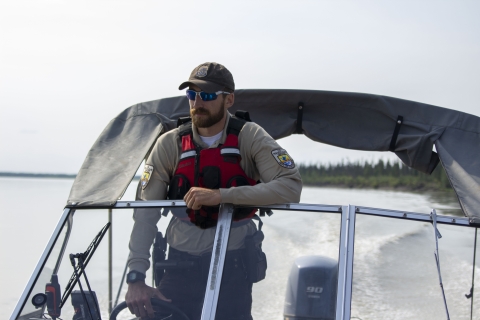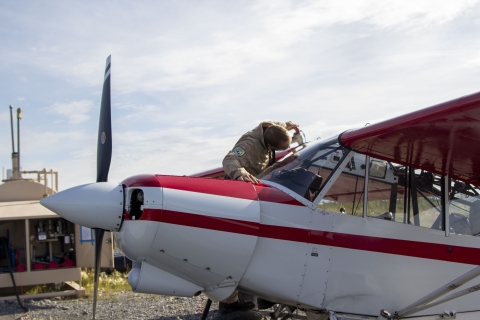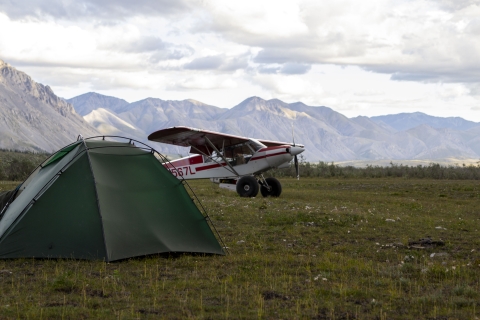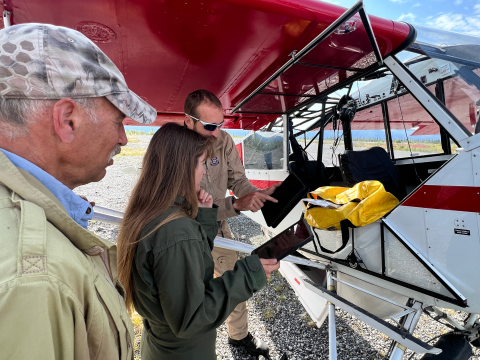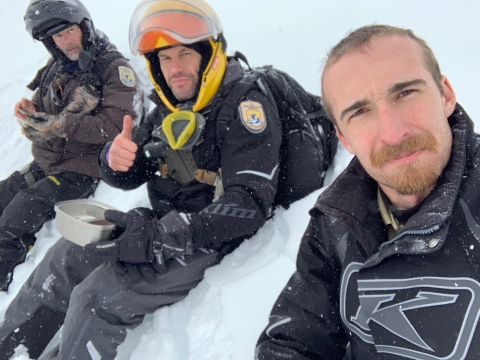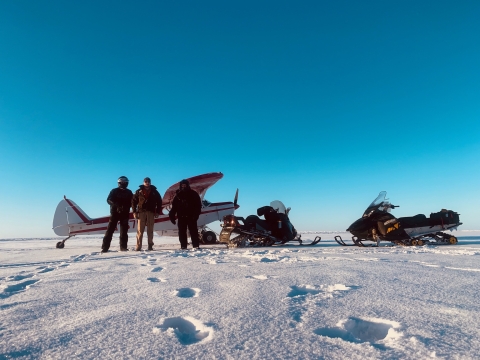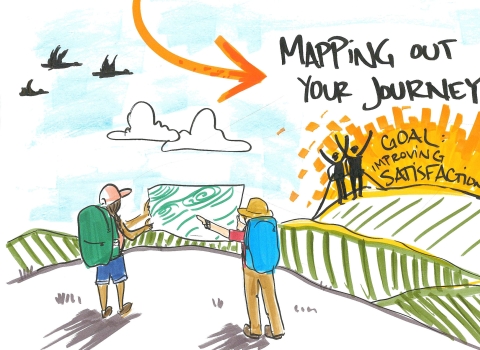How do you pack for a patrol of an area the size of Mississippi? What do you pack? A lunch? What about a week's worth of food, a tent, sleeping bag, and your flight helmet? Those are exactly what Senior Federal Wildlife Officer (SFWO) Cody Smith packs at a minimum for a patrol of his over 67-million-acre assignment area across the entire “North Zone” of Alaska. This zone stretches from the Arctic Ocean to the mouth of the Kuskokwim River.
The U.S. Fish and Wildlife Service employs approximately 200 Federal Wildlife Officers (FWO) around the country. Federal Wildlife Officers are law enforcement professionals charged with protecting natural resources and public safety across the National Wildlife Refuge System. The National Wildlife Refuge System is a network of public lands and waters managed by the U.S. Fish and Wildlife Service. There are more than 560 refuges spanning the country. A day in the life of a Federal Wildlife Officer is going to look very different depending on their duty location. For FWO’s in Alaska, the sheer size of their patrol areas presents logistical obstacles no other officers have anywhere else in the country. The 16 National Wildlife Refuges in Alaska cover over 76 million acres.
“The view from the office is pretty good.” SFWO Smith as he flies above Arctic National Wildlife Refuge.
Senior Federal Wildlife Officer Cody Smith has served with the U.S. Fish and Wildlife Service over seven years. Following the start of his federal service with the Forest Service, Smith moved through various positions gaining experience with operating heavy equipment, biology aid, wildland firefighter, interpretive ranger, and trail crewmember; eventually landing a position as a law enforcement officer at the Rocky Mountain National Park. Since moving over to the U.S. Fish and Wildlife Service, Smith’s stations have included the Tensas River National Wildlife Refuge in northern Louisiana and Alaska. Both a Pilot and outdoorsman, Smith grew up in the Ozarks and enjoys the challenges of working in the wilderness. “This was like Disneyland!” he exclaims about his move to Alaska. His duties as a Pilot also take him across Alaska supporting most of the 16 National Wildlife Refuges across the state. He is currently assigned to Arctic National Wildlife Refuge, Yukon Flats National Wildlife Refuge, and Tetlin National Wildlife Refuge.
Many USFWS staff, such as biologist and park rangers, plan their “field work” to help support the management of fish, wildlife, and their ecosystems on refuges. They may have a variety of trips each year, staying out in remote areas for extended periods of time with a group of biologists and a field camp. For Refuge Law Enforcement FWOs, this is a regular occurrence all year long. Rain, shine, or snow, FWOs are out patrolling their assigned refuge, and often solo. Planning for these trips must be flexible and are determined by the needs of the refuge and the intent of a patrol.
What are your big challenges? Big picture stuff?
“A big one is the shortage of personnel. Time is spent split helping other refuges officers along with my own refuges.– The logistics of doing anything. It’s not like being an FWO anywhere else in the country. I can’t just hop in my rig and go patrol the refuge for the day, come home and eat dinner with the family, and the next day go gas up at a gas station and go drive. Usually, it’s days of planning before any of these patrols and figuring out fuel stops and weather. And then you go do it, and you get back and it is usually a day or two of rehabbing gear and drying equipment out and getting maintenance done on the plane and planning the next one to go out for another week.”
“Aviate, navigate, and communicate." An axiom SFWO Cody Smith lives by in the air.
For USFWS staff across Alaska, aviation is essential. Whether by fixed-wing, or helicopter, aviation allows Service staff to reach their most remote workplaces. This is especially true for law enforcement officers. Department of Interior (DOI) runs a small fleet of aircraft and skilled pilots based in Anchorage, Alaska that help support USFWS in getting staff to areas off the road system. For local Refuge Law Enforcement, there is an increased efficiency in having a pilot of their own. SFWO Smith is one of the few selected, and the only law enforcement officer, successful in the DOI Developmental Pilot Program. This program helps take already privately licensed pilots and helps them get the additional certifications to be “carded” to fly for the department. The program helps eager candidates who would make great DOI pilots, obtain certifications that otherwise may be extremely difficult to obtain.
Alaska is the only region where U.S. Fish and Wildlife Service employs FWO/Pilots. As one of two Refuge Law Enforcement Officer/Pilots in Alaska, Smith stays busy assisting other FWOs in getting to their assigned patrol areas. This common occurrence takes Smith to nearly every other refuge in the state. It is a team effort, as officers are regularly pulled from their assigned refuges to assist other in the region for events such as highly anticipated hunts with large numbers of participants.
For those who work in remote areas of Alaska, life is different. There are different end goals, different roles, and different organizations, but everyone is there to support one another. Smith regularly encounters a small community of aviators and outdoor guides. Relationships are friendly and the hospitality of guides in their base camps is unmatched. SFWO Smith carries himself in a professional manner and it is clear he works to serve the public and protect refuge lands. There is a silent understanding that in a time of need, everyone can count on one another for help. Encounters on the refuge sometimes look more like old friends catching up, but there is a clear line of professionalism that can be seen during the encounters. Good relationships also extend to the other law enforcement officers that patrol the areas adjacent to refuges such as Arctic National Wildlife Refuge. Law enforcement officers patrolling northern Alaska can be counted on one hand and work for agencies such as the National Park Service and the Alaska State Troopers.
Community, patience, preparedness, and resources are tools SFWO Cody Smith relies on daily to perform his duties in National Wildlife Refuge System. As you prepare for a day trip or weeklong adventure, you can rest assure that Refuge Law Enforcement Officers are committed to protecting wildlife and habitat and making refuges safe places for staff and visitors.
In Alaska we are shared stewards of world renowned natural resources and our nation’s last true wild places. Our hope is that each generation has the opportunity to live with, live from, discover and enjoy the wildness of this awe-inspiring land and the people who love and depend on it.

